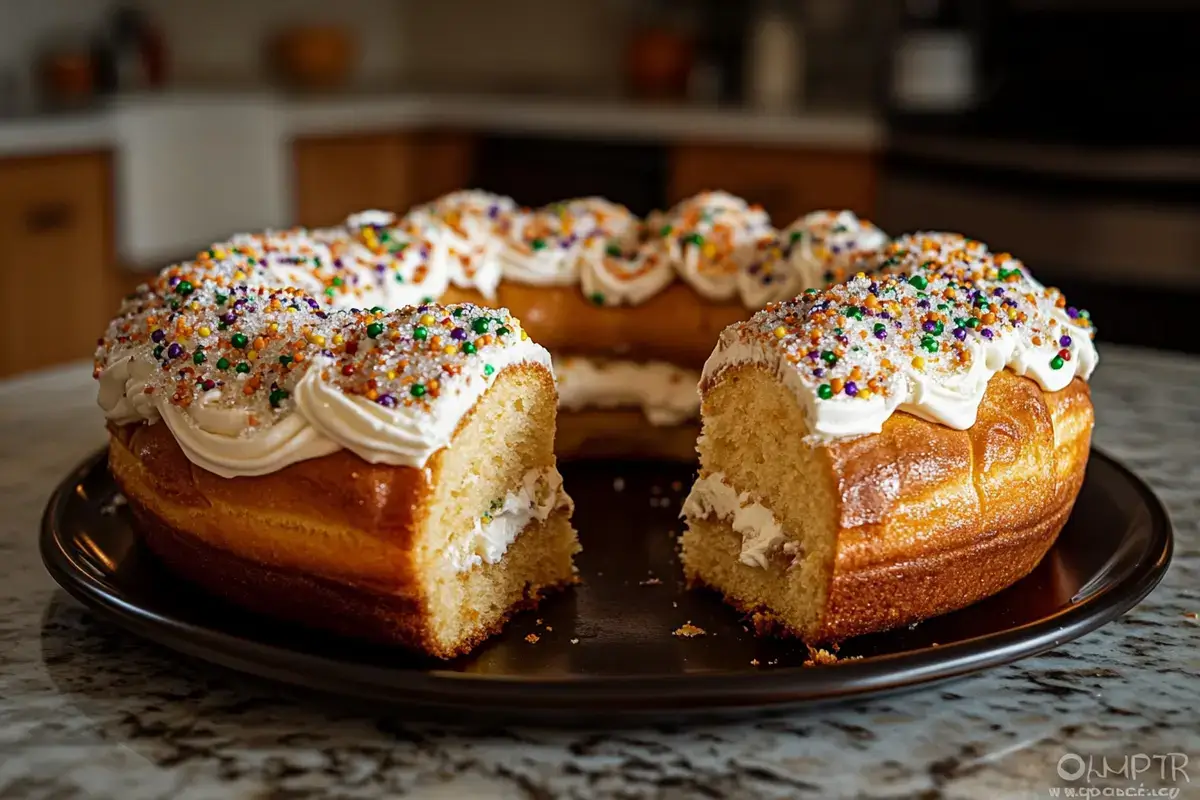Introduction
What is the best filling for a king cake? Many dessert lovers ask this question every Mardi Gras season. King cakes dazzle with bright sprinkles, vibrant colors, and hidden baby figurines. The aroma of fresh dough, combined with sweet or savory fillings, makes these festive pastries an essential part of carnival traditions. Selecting the ideal filling transforms an ordinary ring of pastry into an irresistible delight shared by friends and family alike.
In this article, we explore popular flavors, discuss traditional versus modern takes, share tips on creating a flawless filled king cake, and provide extra insights on regional variations, troubleshooting, and more. By the end, you will know exactly what to consider when someone asks, “What is the best filling for a king cake?” Let’s begin this delicious journey.
Before diving into the specifics, it’s worth noting that the practice of enjoying king cakes during the carnival season dates back centuries. This cherished custom brings people together in celebration, underscoring the communal spirit of Mardi Gras. Whether you’re new to king cakes or an experienced baker seeking inspiration, the right filling can bring fresh excitement to this time-honored tradition.
A Brief History of King Cakes
The king cake tradition dates back to European Epiphany customs, celebrated on January 6 to honor the visit of the Magi. Over centuries, these customs blended with New Orleans culture, resulting in the iconic king cake we see today. Bright sugar in purple, green, and gold adorns the top, reflecting the classic Mardi Gras colors.
Originally, king cakes were simple sweet breads sprinkled with cinnamon or sugar. As they gained popularity, bakers began adding fillings to boost flavor and texture. Some families hide a bean or figurine inside to symbolize luck or prosperity, passing on the tradition of hosting the next gathering to whoever finds it. This playful element of surprise fosters excitement at every slice, tying the cake’s history to its modern-day festivities.
In different parts of the world, similar traditions unfold around this time. For instance, in some European countries, a “Three Kings Bread” appears on tables for Epiphany, often baked with dried fruits or sweet dough. Though the specifics vary, the shared themes of community and celebration remain at the heart of these customs.
Why Fillings Matter?
Fillings can turn a basic sweet bread into a mouthwatering masterpiece. The dough itself is lightly sweetened, providing a blank canvas for countless variations. Cream cheese or fruit jams offer lively contrasts, while praline or caramel fillings contribute decadent sweetness. Even savory options like spinach and cheese bring fresh appeal to this iconic pastry.
Choosing the right filling depends on your preference and the occasion. A classic cream cheese may satisfy traditionalists, while an inventive fusion flavor might surprise your guests. Ultimately, the filling you select helps define the taste, texture, and overall impression of your king cake.
Moreover, fillings do more than enhance flavor. They also affect how you experience each bite. A properly balanced filling can highlight the dough’s delicate sweetness or offer a contrasting tang. In many cases, the color and texture of the filling can elevate the presentation, making the cake look as exciting as it tastes.
Common Filling Types:
- Cream Cheese
A crowd favorite, cream cheese offers tanginess that pairs well with the sweet dough. Bakers often sweeten and whip it for a smooth, luxurious texture. When combined with a little vanilla extract, it becomes an irresistible layer of creamy goodness. - Fruit Preserves
Strawberry, raspberry, or apple fillings add a refreshing, fruity element. Some bakers experiment with tropical flavors like pineapple to bring a sunny twist. Fruit preserves can also be blended with spices, such as cinnamon or nutmeg, for a more complex taste experience. - Praline or Nut Mixtures
Combining brown sugar, butter, and pecans creates a crunchy, caramel-like center that honors the South’s culinary roots. Variations might include walnuts or almonds, offering different textures. The subtle smoky notes of toasted nuts pair beautifully with the sweet dough. - Chocolate or Caramel
Rich and indulgent, these fillings appeal to sweet-toothed enthusiasts. They can easily overwhelm subtler dough flavors, so moderation is key. A drizzle of salted caramel or a light layer of chocolate ganache can add a gourmet twist without making the cake overly sweet. - Savory Fillings
Options like spinach and cheese cater to those who prefer a non-traditional twist, showcasing the dough’s adaptability. Other savory ideas might include seasoned meats, roasted vegetables, or herbed spreads. These are less common but can be a fun surprise at brunch or potluck events.
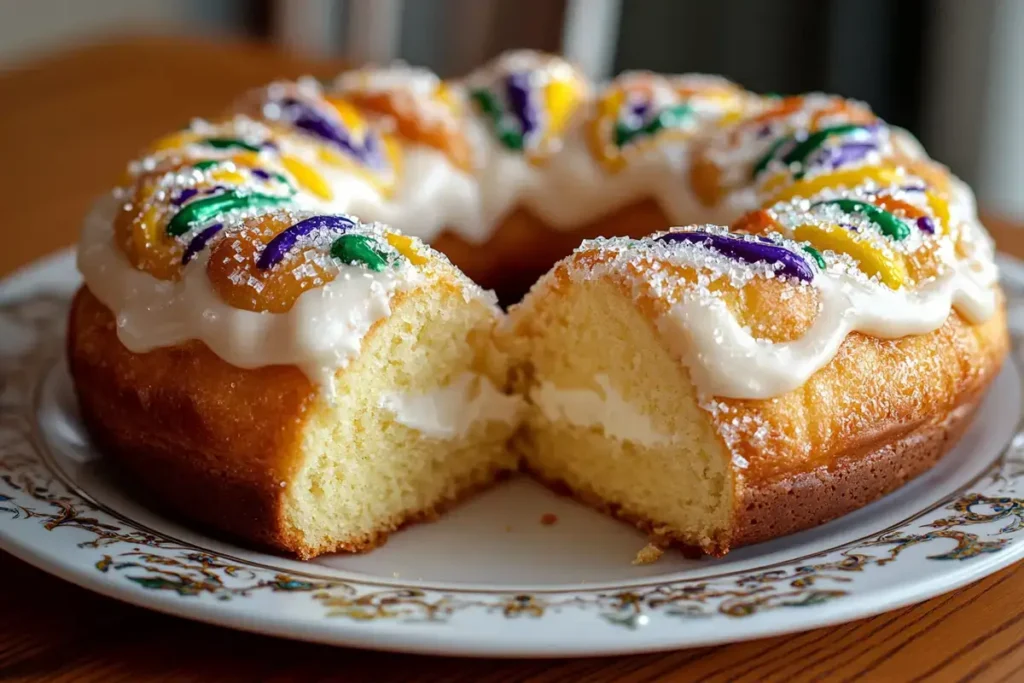
Choosing the Perfect Filling
When deciding what is the best filling for a king cake, weigh personal tastes, the event vibe, and flavor balance. A tangy cream cheese can offset sweet dough, while a praline mixture offers a bold sugary crunch. For novelty, a savory version can intrigue your guests.
Flavor Pairings:
Think of how flavors interact. Too much sugar can be cloying, so consider adding tart or citrusy notes to maintain balance. Vibrant fruit fillings also provide a visual pop, making the cake inviting once sliced. If you’re adding spices to your dough, choose a filling that complements rather than clashes with those spices.
Tips for Sweetness:
Pair sweet dough with contrasting fillings like cream cheese or fruit jam. Reduce sugar in your cream cheese filling if you want its tangy flavor to shine. Above all, aim for a harmonious blend of tastes that keeps guests reaching for more. If you worry about overpowering sweetness, try replacing some of the sugar with natural sweeteners, such as honey or maple syrup, for a subtle difference in flavor.
Step-by-Step Guide to Filling a King Cake
- Prepare the Dough
Make or purchase a reliable king cake dough. Allow it to rise according to your recipe, ensuring it becomes soft and pliable. The dough’s elasticity is crucial for holding the filling without tearing. - Roll and Fill
Roll the dough into a rectangle on a floured surface. Spread the filling evenly, leaving a small border. Carefully roll the dough into a log, then form a ring. Make sure you press lightly so the filling stays in place. - Insert Trinket (Optional)
Gently hide a plastic baby or small figurine in the underside of the dough ring if you wish to maintain tradition. Be sure to remind guests there’s a surprise inside! - Bake and Cool
Bake until golden brown and cooked through. Let it cool fully to preserve the filling’s consistency and prevent leaking. If the cake is still too warm when you slice, the filling might ooze out prematurely. - Decorate
Drizzle with icing and top with purple, green, and gold sugar for a classic Mardi Gras look. If you prefer a different theme, customize your toppings accordingly. Sprinkles, edible glitter, or finely chopped nuts can add extra flair.
This process accommodates any filling, highlighting how adaptable a king cake can be. Whether you stick to classic flavors or experiment with new ideas, your cake can truly shine. For those new to baking, practice makes perfect: each attempt will help you refine your technique and discover new flavor combinations.
Regional Variations of King Cake Fillings
While New Orleans is often seen as the heart of king cake traditions, other regions have their own twists. In some Gulf Coast areas, you may encounter king cakes brimming with roasted pecans and brown sugar. Along the West Coast, bakeries might feature fruit-forward options like blueberry or even fusion flavors like matcha-raspberry. In certain global regions—such as parts of Europe—traditional recipes resemble brioche loaves studded with candied fruits instead of modern fillings. These variations prove that the question “What is the best filling for a king cake?” has countless answers depending on local culture and personal taste.
Even within New Orleans, you’ll find a huge range of fillings in different bakeries. Some shops pride themselves on their signature praline filling, while others experiment with salted caramel or spicy chipotle-infused chocolate. This diversity ensures that every Mardi Gras season brings fresh surprises, appealing to both loyal traditionalists and adventurous flavor seekers.
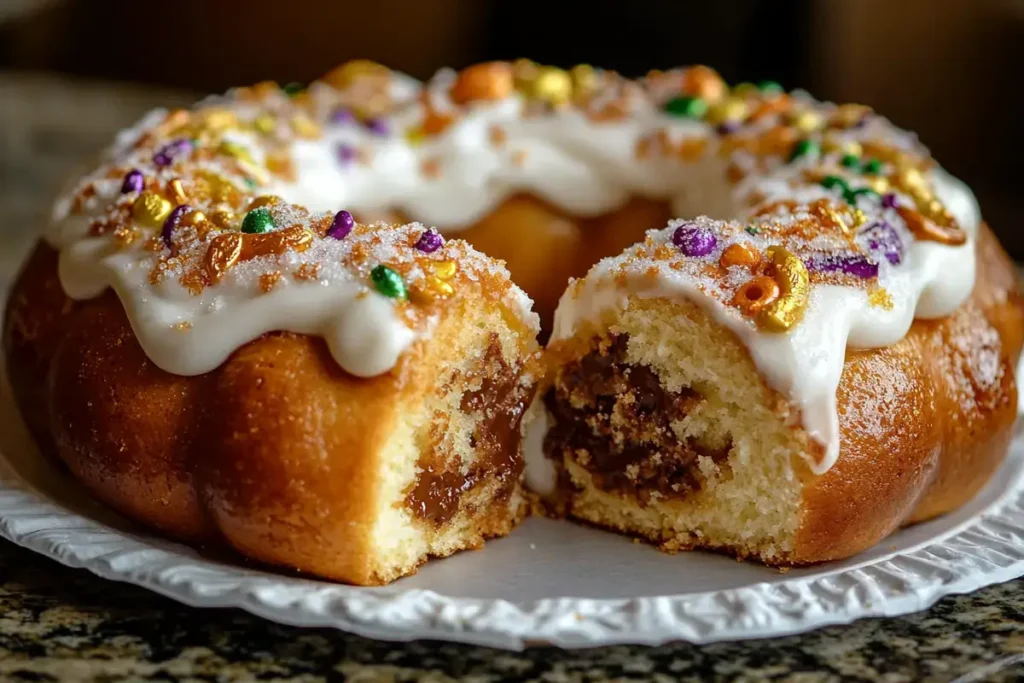
Serving and Storing Tips
Proper serving and storage can ensure your king cake remains fresh and delicious:
- Serving Temperature
Serve your king cake at room temperature. This allows the dough to remain soft and the filling to present its fullest flavor. If you’re serving a savory version, consider warming it slightly to enhance the flavors of the filling. - Storage
If your filling contains dairy (like cream cheese), store any leftovers in the refrigerator to prevent spoilage. Place the cake in an airtight container or wrap it in plastic wrap to keep it moist. For fruit-based fillings, refrigeration also helps maintain the filling’s freshness. - Reheating
If you prefer a slightly warm slice, zap it in the microwave for a few seconds. However, be cautious not to overheat, as the filling may become runny or lose its texture. Alternatively, you can warm slices in a low-temperature oven for a crispier exterior.
By following these guidelines, you’ll be able to enjoy every last slice with the same delicious taste and texture it had when freshly baked. Proper storage and reheating techniques keep each piece satisfying down to the final crumb.
Troubleshooting Common Mistakes
Even seasoned bakers can encounter issues. Here are a few tips:
- Filling Leaks
If the filling oozes out, you may have used too much or spread it too close to the edge. Next time, leave a slightly larger border and ensure the edges are sealed well. Double-check that the dough hasn’t developed thin spots or small tears. - Dry Dough
Overbaking can result in a dry texture. Keep an eye on the oven and remove the cake once it turns golden brown. If your oven runs hot, reduce the temperature slightly or shorten the baking time. - Underbaked Center
A dense or doughy center often means the cake needs more time. Check for doneness by gently tapping the surface or using a toothpick. If it emerges clean, the cake is ready. Remember that higher sugar content in fillings might slow down the baking process. - Lack of Flavor
If your cake seems bland, consider adding spices (like cinnamon or nutmeg) to the dough or enhancing the filling with zesty notes (e.g., lemon zest in cream cheese). Balancing sweetness, salt, and acidity can transform a muted flavor profile into a vibrant one. - Excess Browning
In some ovens, the top can brown faster than the inside can bake. To avoid this, lightly tent the cake with aluminum foil once it reaches the desired color. This step can help the center bake thoroughly without burning the surface.
Traditional vs. Modern Takes
Traditional king cakes often contain minimal cinnamon swirl and rely on colorful sugar for flavor and flair. Modern versions feature diverse fillings—cookie butter, matcha creams, peanut butter, or even savory ingredients. Whether you favor simplicity or innovation, variety and personalization keep this centuries-old tradition thriving.
Another modern twist includes decorating the cake with fresh fruit or gourmet toppings like toasted coconut flakes and artisanal drizzles. These spins on classic decoration showcase how today’s bakers continue to evolve the king cake tradition, blending nostalgia with culinary creativity.
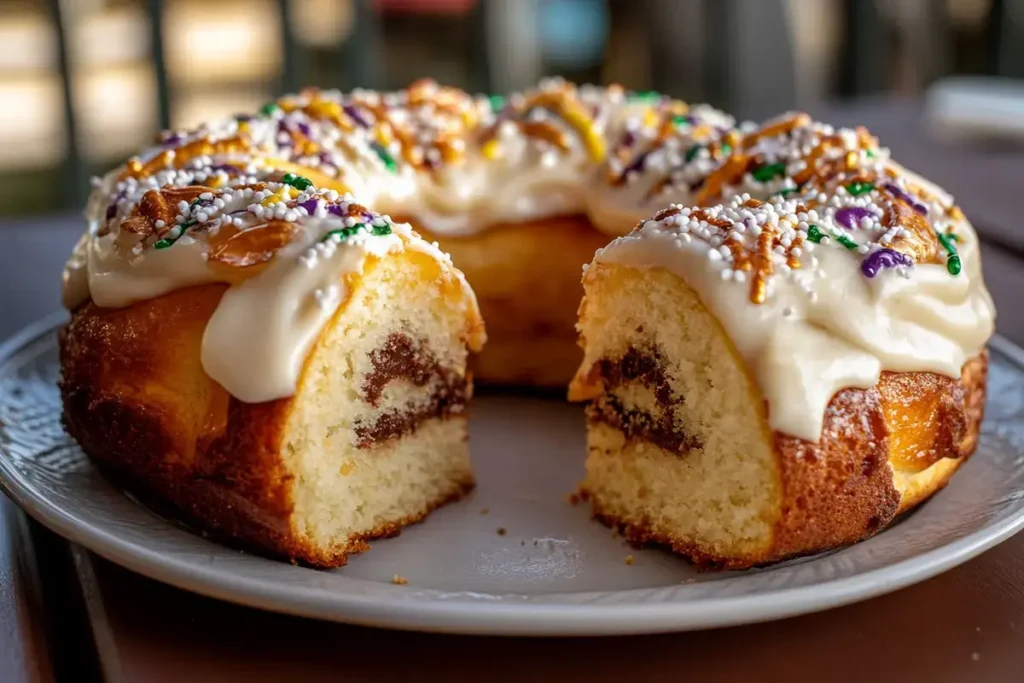
Tips for a Flawless Filling
- Use Thick Fillings
Thin or runny fillings can leak, leading to a soggy cake and uneven bake. Thicker mixtures also help distribute flavor more consistently. - Chill Your Filling
Cooler fillings stay stable during baking, reducing the risk of overflow. For fruit preserves, chilling can firm up the jam, making it less likely to seep out. - Don’t Overfill
Excess filling can burst the dough. Aim for a balanced ratio of dough to filling. While it’s tempting to pack in more flavor, too much can compromise the cake’s structure. - Secure the Edges
Pinch seams firmly or use an egg wash to seal. This prevents leaks and preserves the ring shape. If the edges do not seal well, consider using a bit of water or milk to create a tighter seal. - Adjust Bake Time
Filled king cakes may need slightly longer to bake thoroughly. Watch for a golden crust. Use a thermometer if needed; an internal temperature of around 190°F (88°C) is often ideal for yeast breads.
Beyond the Ordinary
If you love the concept of sweet or savory stuffed dough, apply these methods to other pastries. Cinnamon rolls or braided breads can feature fruit preserves, nuts, or cheeses. Individual king cakes are another creative alternative, granting each guest a personal, perfectly filled piece. These variations show how a single dough recipe can yield endless flavorful possibilities.
Additionally, you can explore regional bakery traditions for more inspiration. For example, the concept of a filled braided bread is common in certain Eastern European pastries. Incorporating their techniques or flavor profiles—like poppy seeds, sweet cottage cheese, or dried fruit—can inspire delicious new takes on your king cake dough.
Decorating Your Cake
Though the filling is the centerpiece, decoration completes the experience. A simple icing of powdered sugar and milk, finished with colored sugars, evokes Mardi Gras flair. If you opt for unique fillings, adjust the glaze to hint at the flavor—maybe a citrus drizzle for fruit or cocoa frosting for chocolate. Use your imagination to create a memorable display.
For extra texture and visual interest, consider garnishing with chopped nuts, fresh berries, or even edible flowers. Small details in presentation often make a big impression, inviting everyone to indulge in a second slice (or more).
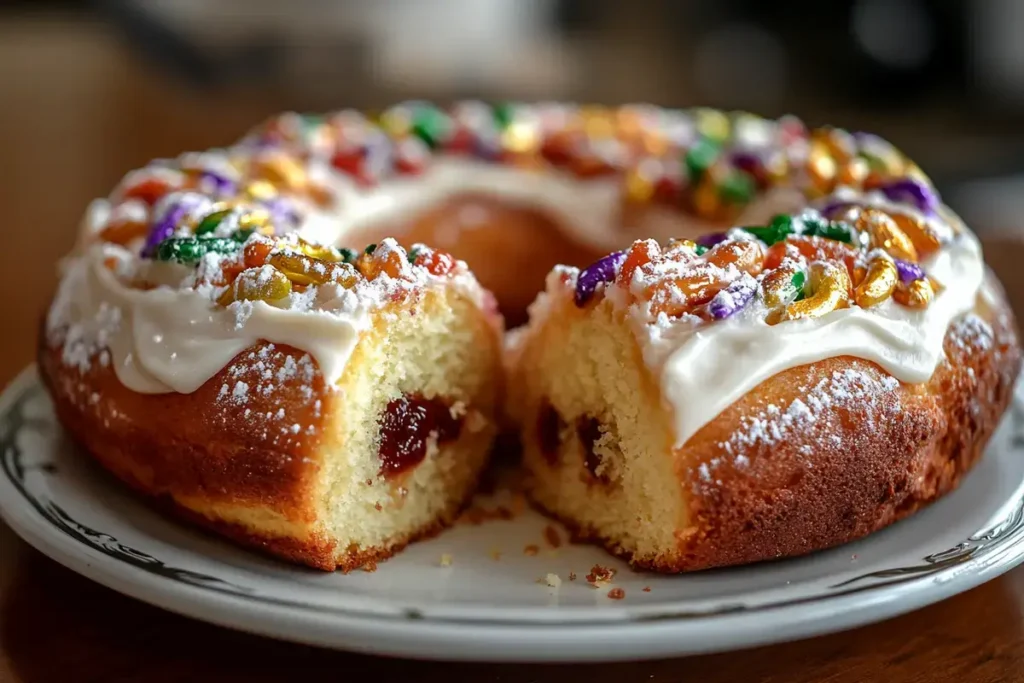
The Festive Spirit
Part of the king cake’s charm is the communal excitement it brings. The ring shape symbolizes unity, while the hidden trinket provides playful suspense. Each slice might reveal the plastic baby, making the finder a guest of honor. Together, these elements turn an ordinary dessert into a shared celebration.
Moreover, king cakes reflect the cultural mosaic of Mardi Gras itself. They invite creativity, encourage social gathering, and celebrate the joy of indulgence. Whether you’re carrying on a family tradition or throwing your first Mardi Gras party, slicing into a king cake can spark conversation, laughter, and friendly competition over who gets the lucky figurine.
Healthier Alternatives and Dietary Choices
- Low-Sugar Options
Experiment with fillings that use fresh or lightly sweetened fruit purées. Slightly reducing sugar in the dough can also help. Stevia, agave, or other natural sweeteners might also be worth trying for those watching their sugar intake. - Gluten-Free Dough
Swap all-purpose flour with gluten-free blends. A bit of experimentation can yield a tasty result that caters to those avoiding gluten. Be sure to include xanthan gum or another binding agent if recommended for your flour mix. - Vegan Variations
Replace dairy and eggs with plant-based alternatives. Coconut milk or almond milk can add moisture, while vegan butter substitutes help maintain richness. Consider using flaxseed or applesauce as a binder in the dough.
In addition to these suggestions, you can incorporate more nutritious ingredients like whole wheat flour, oats, or flax seeds to boost fiber and vitamins. While these swaps may alter the texture and taste of the dough, they ensure a broader range of people can enjoy this festive treat without sacrificing tradition entirely.
Keeping Tradition Alive
Whether you crave the simplicity of cinnamon or the complexity of praline, the joy lies in sharing a tasty slice with friends and family. Asking “What is the best filling for a king cake?” fuels ongoing innovation. By combining dough, creativity, and festive spirit, you carry on a tradition that continues to enchant year after year.
Many households hold friendly debates on which filling reigns supreme, passing down their treasured recipes through generations. Others host festive baking parties, where participants experiment with an array of flavors—from classic to unconventional. Through these shared moments, the king cake lives on, evolving with every enthusiastic baker who dares to personalize it.
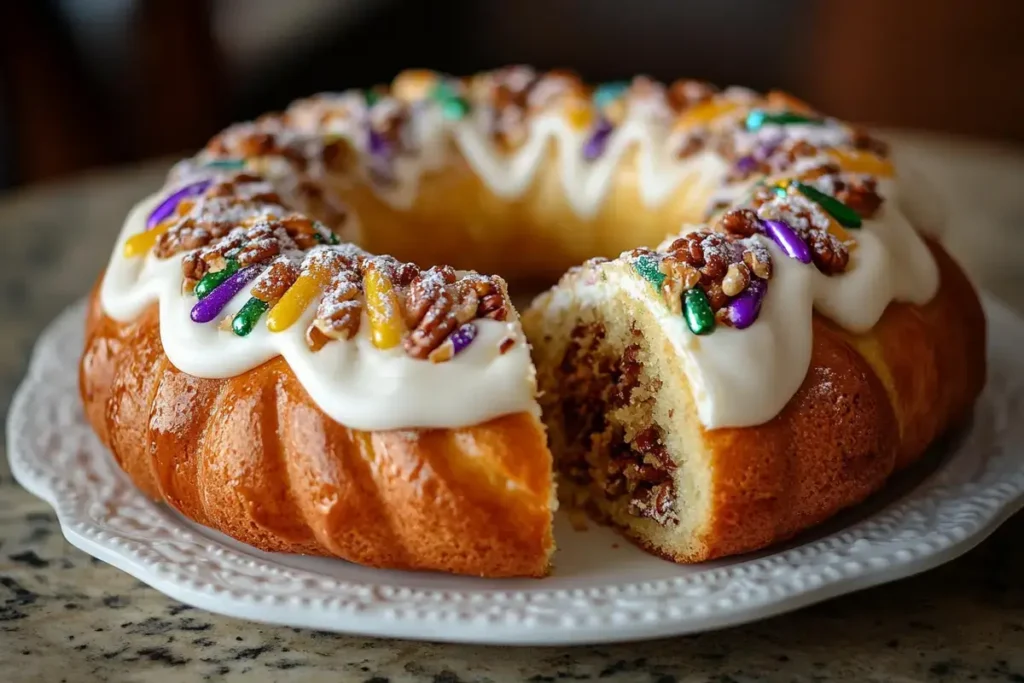
FAQs
What is the most popular king cake filling?
Many believe cream cheese is the frontrunner. Its tangy flavor balances the cake’s sweetness, and its smooth texture creates an indulgent center. Fruit fillings rank close behind, offering bright bursts of taste and color.
Are traditional king cakes filled?
Originally, they were not. Early king cakes often resembled plain sweet bread with a sprinkle of cinnamon or sugar. Over time, bakers began adding fillings like cream cheese and fruit preserves, sparking new varieties and debate about what constitutes a “true” king cake.
Does a cream cheese king cake need to be refrigerated?
Yes, it does. Because cream cheese can spoil if left out too long, store leftovers in the refrigerator. Let the cake return to room temperature before serving to soften the filling and maintain its best flavor.
What to put in king cake?
There are countless options. Cream cheese, fruit preserves, praline, chocolate, or even savory fillings like spinach and cheese can all shine. Pick your filling based on personal preference or the gathering’s theme. From traditional to adventurous, a well-chosen filling elevates the king cake experience.

